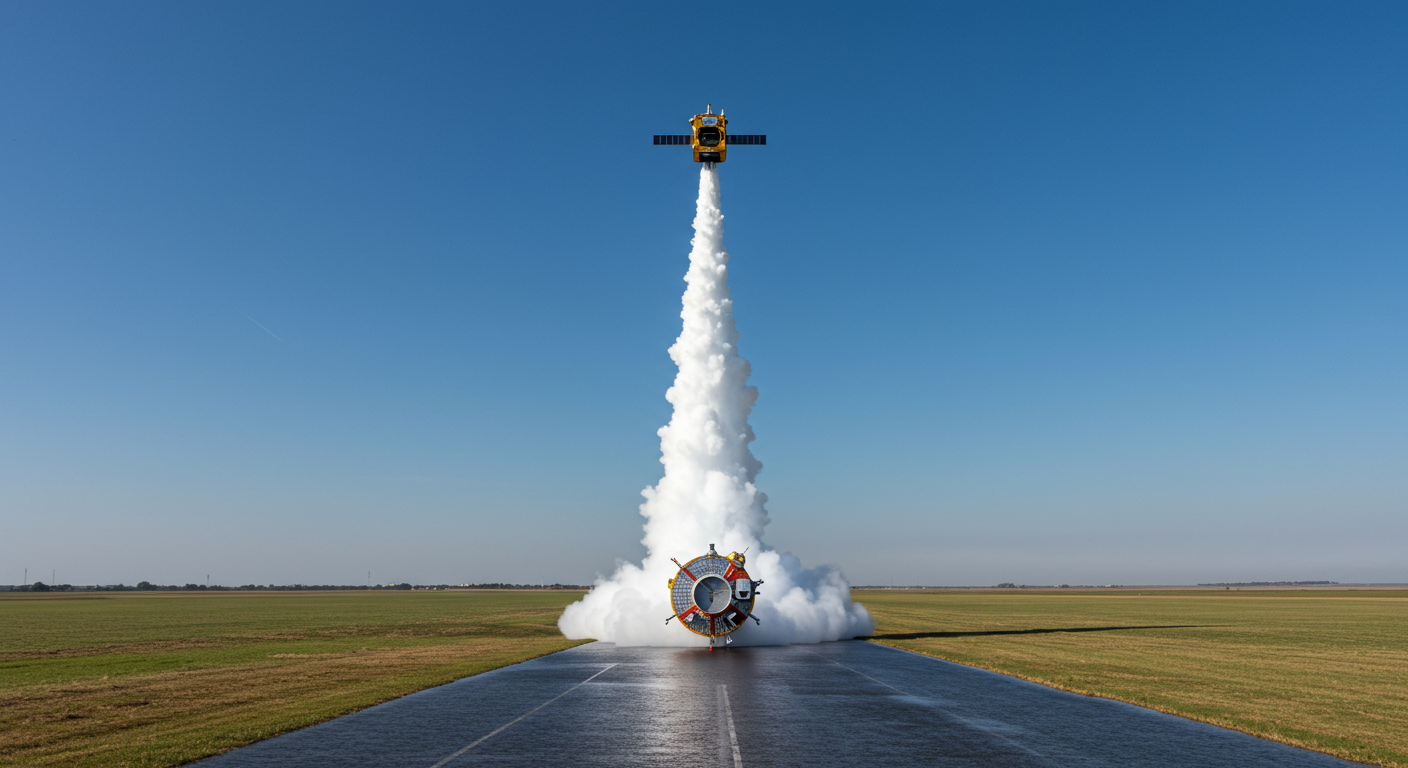Get ready, Earthlings! A monumental event is on the horizon that promises to change the way we understand our planet. Imagine a satellite so advanced it can peer through dense forests, measure minute changes in land, and track the subtle movements of glaciers, all from space. This isn’t science fiction; it’s the reality of the upcoming NISAR satellite mission. This incredible collaboration between two of the world’s leading space agencies, NASA and ISRO, is poised to launch on July 30, 2024, embarking on a journey that will unlock countless secrets about Earth’s dynamic processes.
For decades, scientists have relied on satellites to monitor our planet. But NISAR, short for NASA-ISRO Synthetic Aperture Radar, is different. It’s not just another eye in the sky; it’s a revolutionary tool designed to give us an unprecedented, detailed view of Earth’s land and ice surfaces. This isn’t just about pretty pictures from space; it’s about collecting vital data that will help us tackle some of the most pressing challenges facing humanity today, from climate change to natural disasters.
What Makes NISAR a Game-Changer?
At the heart of NISAR’s groundbreaking capabilities is its unique dual-frequency radar system. Most Earth-observing radar satellites use a single frequency, which limits what they can “see” on the ground. But NISAR combines two distinct radar frequencies: the L-band, provided by NASA, and the S-band, contributed by ISRO. Think of it like having two different types of vision, each revealing unique details.
The L-band radar is incredibly powerful. It can penetrate through dense vegetation, snow, and even ice, allowing scientists to see changes happening beneath the surface that were previously hidden. This means we can accurately measure how much carbon is stored in forests, track the movement of massive ice sheets, and understand the stability of permafrost in thawing regions. Imagine being able to “see” the exact amount of biomass in a rainforest, or how fast a glacier is melting, even if it’s covered in snow. That’s the power of L-band.
Complementing the L-band is ISRO’s S-band radar. While the L-band is great for looking *through* things, the S-band is highly sensitive to the Earth’s surface roughness and soil moisture. This allows scientists to map agricultural areas, monitor crop health, detect areas prone to flooding, and track changes in wetlands with incredible precision. Together, these two radar frequencies provide a holistic picture of our planet, offering insights that neither could achieve alone. It’s a truly synergistic approach to Earth observation.
A Global Watcher, Every 12 Days
NISAR isn’t just about advanced technology; it’s about systematic, global coverage. Once operational, the satellite will orbit the Earth in a near-polar, low-Earth orbit, approximately 747 kilometers above us. This specific orbit allows NISAR to cover the entire land and ice surfaces of our planet every 12 days. This consistent, repetitive coverage is crucial for monitoring subtle, long-term changes, as well as rapid events.
Imagine having a meticulous surveyor that revisits every corner of the globe twice a month, precisely measuring every bump, every shift, and every drop of moisture. This frequent data collection will build a comprehensive, time-series record of Earth’s dynamic systems, providing an unprecedented baseline for understanding natural processes and human impacts. Over its expected mission duration of at least three years, NISAR will accumulate a treasure trove of data.
Unveiling Earth’s Secrets: Key Applications
The data collected by NISAR will have far-reaching applications, impacting various fields crucial for the well-being of our planet and its inhabitants.
Understanding Climate Change
One of NISAR’s primary goals is to help us better understand the critical drivers and impacts of climate change. By precisely measuring changes in ice sheets and glaciers, scientists can refine predictions about sea level rise. Its ability to quantify forest biomass will improve estimates of carbon stored in ecosystems, which is vital for understanding the global carbon cycle. Monitoring thawing permafrost, a significant source of greenhouse gas emissions, will also be enhanced. These insights are indispensable for developing effective climate mitigation and adaptation strategies.
Think of the Amazon rainforest, often called the “lungs of the Earth.” NISAR will be able to map deforestation and forest degradation with unprecedented accuracy, even under cloud cover. This capability is critical for conservation efforts and for tracking carbon emissions from land-use change, which is a major contributor to global warming. Similarly, monitoring the vast, fragile Arctic and Antarctic regions will provide crucial data on glacial melt, a direct consequence of rising global temperatures.
Disaster Management and Preparedness
NISAR’s data will be invaluable for anticipating and responding to natural disasters. It can detect ground deformation that precedes earthquakes and volcanic eruptions, providing potential early warnings. By mapping flood-affected areas and monitoring soil moisture, it can assist in flood prediction and disaster relief efforts. Its ability to see through clouds and darkness means it can provide critical information immediately after a disaster, when traditional imaging systems might be hindered.
Consider a major earthquake. NISAR’s interferometric capabilities can map the exact ground deformation caused by the event, helping emergency responders understand the extent of damage and plan recovery operations more effectively. For volcanoes, subtle changes in the ground’s surface can indicate an impending eruption, and NISAR will be able to spot these changes, potentially saving lives by allowing for timely evacuations.
Agriculture, Forestry, and Water Resources
For farmers and resource managers, NISAR will offer a wealth of information. Its S-band radar is excellent for monitoring soil moisture content, which is vital for irrigation management and crop yield prediction. It can also map agricultural land use, track crop growth cycles, and assess the impact of droughts or excessive rainfall. In forestry, beyond biomass estimation, it can help manage forest health and detect illegal logging. When it comes to water, NISAR will help monitor wetlands, crucial ecosystems that support biodiversity and provide natural flood control.
Imagine farmers in water-stressed regions receiving precise, satellite-driven data on when and where to irrigate their fields, optimizing water use and maximizing yields. Or forest managers being able to identify areas affected by disease or pests before they spread widely. These practical applications translate directly into improved food security and more sustainable resource management globally.
The Power of Partnership: NASA and ISRO
The NISAR mission stands as a shining example of international scientific collaboration. It’s a testament to what can be achieved when nations pool their expertise and resources for the common good. NASA, the U.S. space agency, contributed the L-band synthetic aperture radar, a high-rate communication subsystem for data transmission, GPS receivers for precise orbit determination, and a solid-state recorder for data storage.
ISRO, India’s space research organization, designed and built the S-band synthetic aperture radar, the sophisticated spacecraft bus that houses all the instruments, and will be providing the powerful Geosynchronous Satellite Launch Vehicle (GSLV) Mark II for its launch from the Satish Dhawan Space Centre in Sriharikota, India. ISRO will also manage the mission operations. This collaborative effort has not only pushed the boundaries of Earth observation technology but has also strengthened ties between two scientific powerhouses.
More Than Just a Satellite: A Tool for Humanity
NISAR is more than just a piece of advanced technology orbiting our planet. It represents a new era in Earth observation, providing data that is accessible to scientists and policymakers worldwide. The insights gained from NISAR will inform critical decisions on land use, disaster preparedness, climate policy, and resource management. It will deepen our understanding of our planet’s complex, interconnected systems, from the deep Earth processes that cause earthquakes to the surface changes brought about by human activity and climate shifts.
This mission underscores the global commitment to protecting our home planet. By providing unprecedented detail and frequency of observation, NISAR will empower researchers, governments, and communities to make more informed decisions, fostering a more sustainable and resilient future for everyone. It’s about giving us the most accurate “health check” on Earth possible.
The Road to Launch and Beyond
The journey of NISAR has been long and meticulous. The L-band payload was handed over by NASA to ISRO in March 2023, where it has undergone extensive integration and testing with the S-band payload and the spacecraft bus. Now, with the launch date set for July 30, 2024, from India’s Satish Dhawan Space Centre, the world eagerly awaits the moment this remarkable satellite begins its mission.
Once in orbit, NISAR will begin its diligent work, beaming back enormous amounts of data that will fuel scientific discoveries for years to come. It’s a mission that truly embodies the spirit of exploration and the power of international cooperation for the benefit of all.
Stay Tuned!
The launch of NISAR is not just a scientific milestone; it’s a global event that will shape our collective understanding of Earth. As we count down to July 30, let’s anticipate the groundbreaking discoveries and invaluable insights this incredible satellite will bring. The future of Earth observation is looking brighter than ever!









